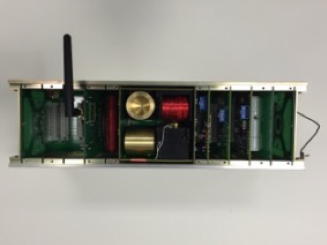Integrated CubeSat Engineering
Brought to AIAA by Teaching Science and Technology, Inc. (TSTI), this Integrated CubeSat Engineering course examines the application of Systems Engineering tools and techniques that will provide participants with an understanding of the scope of the skills, industry standards, information, and tools necessary to plan a credible CubeSat Development Program. Emphasis is on practice over theory using a fully-functional (hardware and software) desktop (non-flight) CubeSat as the system of interest. The course uses the 3U EyasSAT3™ (ES3) desktop satellite (Figure 1), and it follows the progression of a hypothetical CubeSat mission – NanoMet – designed to deliver large scale meteorological imagery from LEO. NanoMet serves as an end-to-end system engineering and project management training platform to examine issues that develop during each phase of a project lifecycle.
Figure 1. EyasSAT3 Layout and Design

The course is organized along the lines of a real space mission, starting with Pre-Phase A concept development and then progressing from Phase A to D, introducing systems engineering artifacts that would be developed at each major milestone and providing hands-on examples using the NanoMet mission. NanoMet, based on the ES3 platform, is designed to conform to the 3U CubeSat standard in terms of form and fit and includes all standard spacecraft bus functions (power, data handling, communication, and 3-axis attitude determination and control). All hardware was designed to be for use around the world and is "ITAR-free," (it is not space-qualified or even qualifiable). Participants are provided with key lectures and resources and through a variety of in-class exercises will learn by doing.
Learning Objectives
- Define mission needs, goals, objectives and ConOps for a CubeSat mission to satisfy Pre-Phase A requirements
- Develop and organize detailed mission and system requirements as required by a Phase A System Requirements Review (SRR)
- Describe the tools and techniques needed to develop the complete preliminary design for a CubeSat and conduct a Phase B preliminary design review (PDR)
- Describe the typical products produced for a critical design review (CDR) at the end of Phase D including system specifications and test plans
- Implement a typical assembly, integration and test plan for a representative CubeSat system to apply the flow down from requirements to verification activities
Who Should Attend
This course intended for Systems engineers, project managers, integrated product team members involved with any aspect of system engineering and analysis, especially design and development, test and evaluation of CubeSats.
Course Information:
Type of Course: Instructor-Led Short Course
Course Level: Intermediate/Advanced
Course Length: 2-3 days
AIAA CEU's available: Yes
- Intro to Space Systems Engineering
- Overview of the NanoMet and the EyasSAT3 System of Interest
- Conceptual Space Mission Design
- Pre-Phase A Planning
- Essential Design Review Products
- Project Scope Definition
- Engineering Tools and Techniques
- Requirements Engineering
- Functional Analysis
- Orbit Design
- Spacecraft Subsystems and Sizing
- Phase B Planning
- Preparing for Space Systems Verification
- Phase C/D Planning
- NanoMet Test Plan
- NanoMet Simulated Operational Review
- Course Review and Wrap-up
